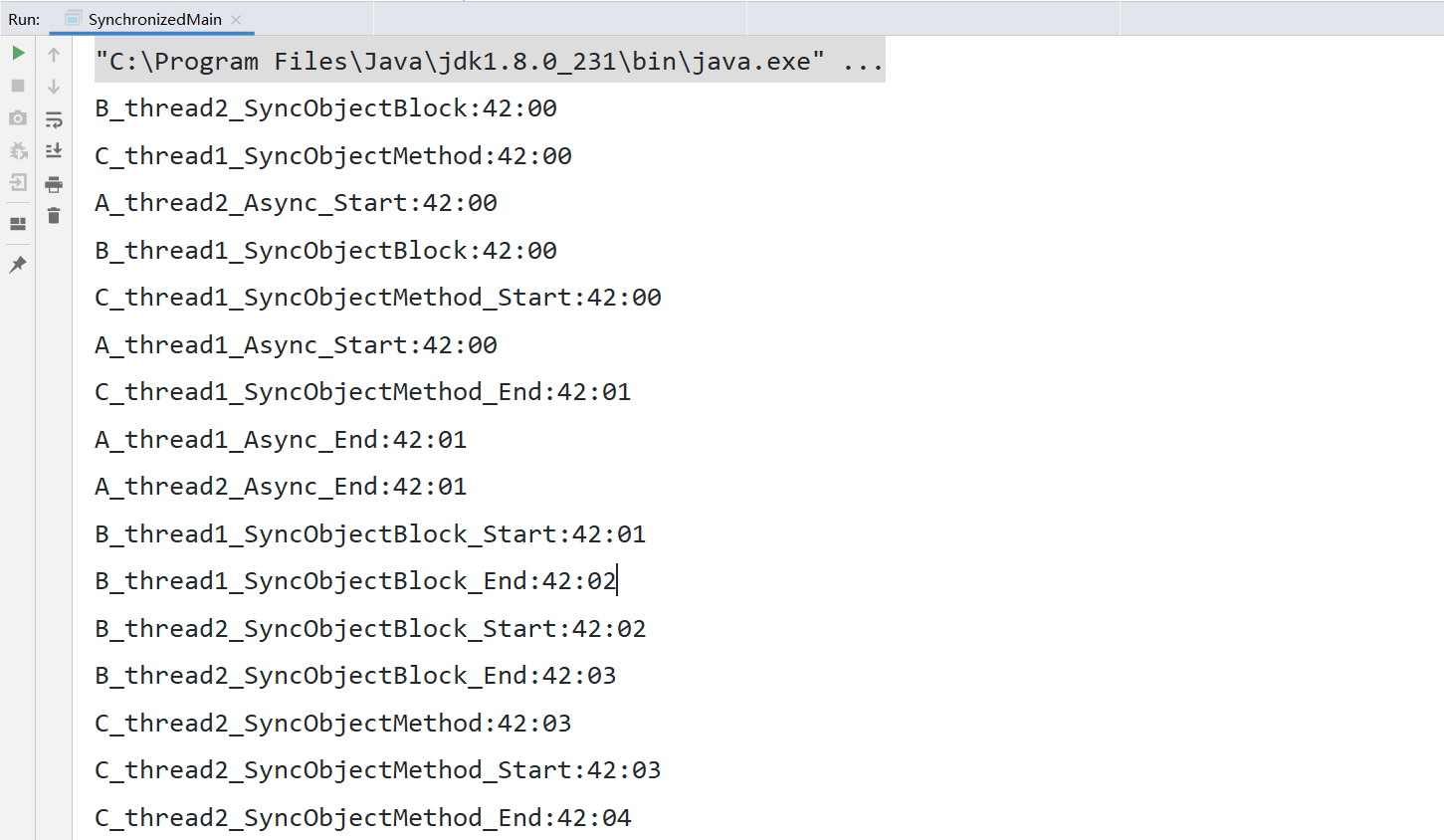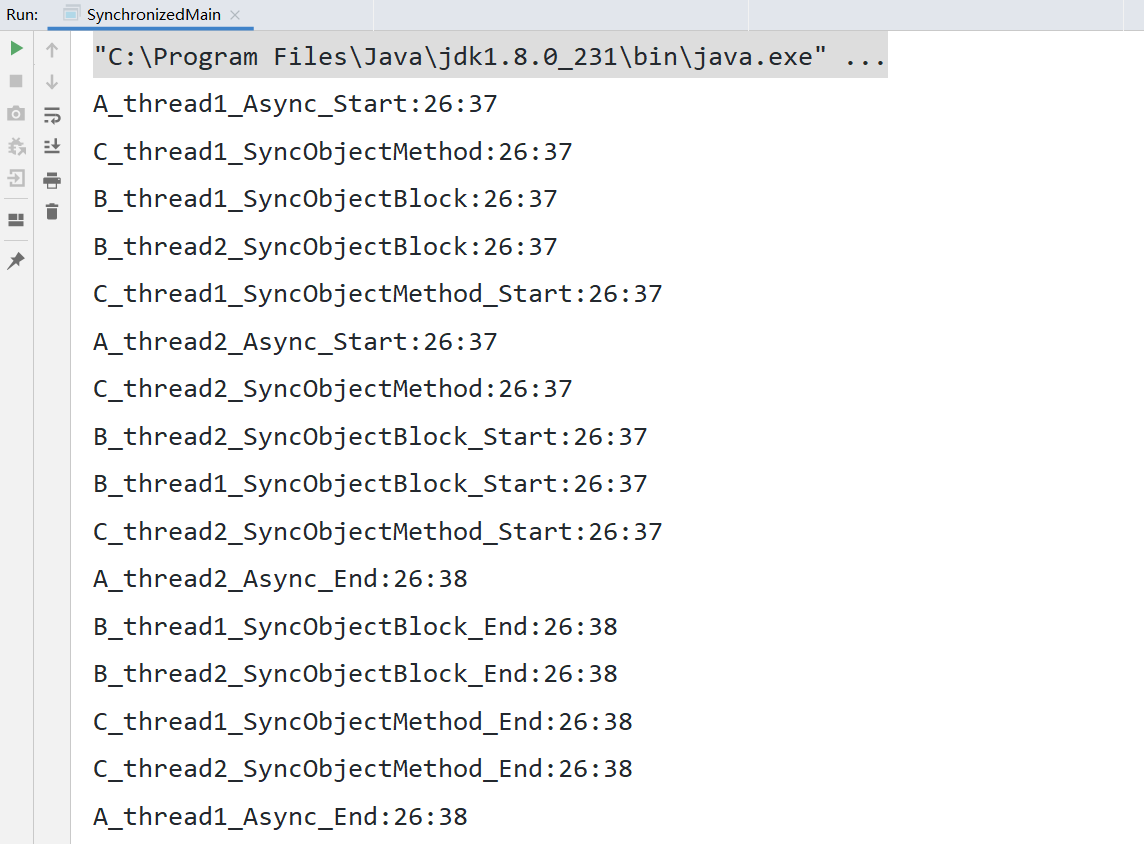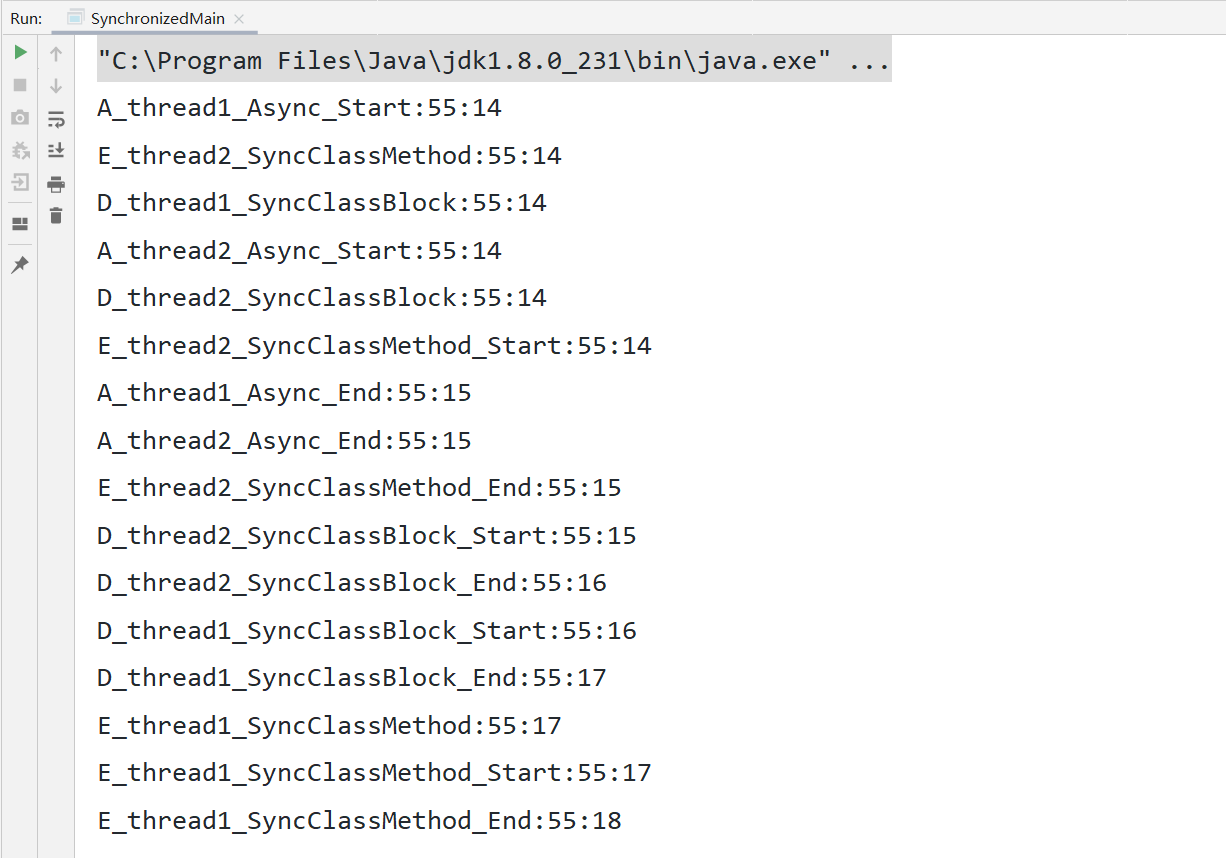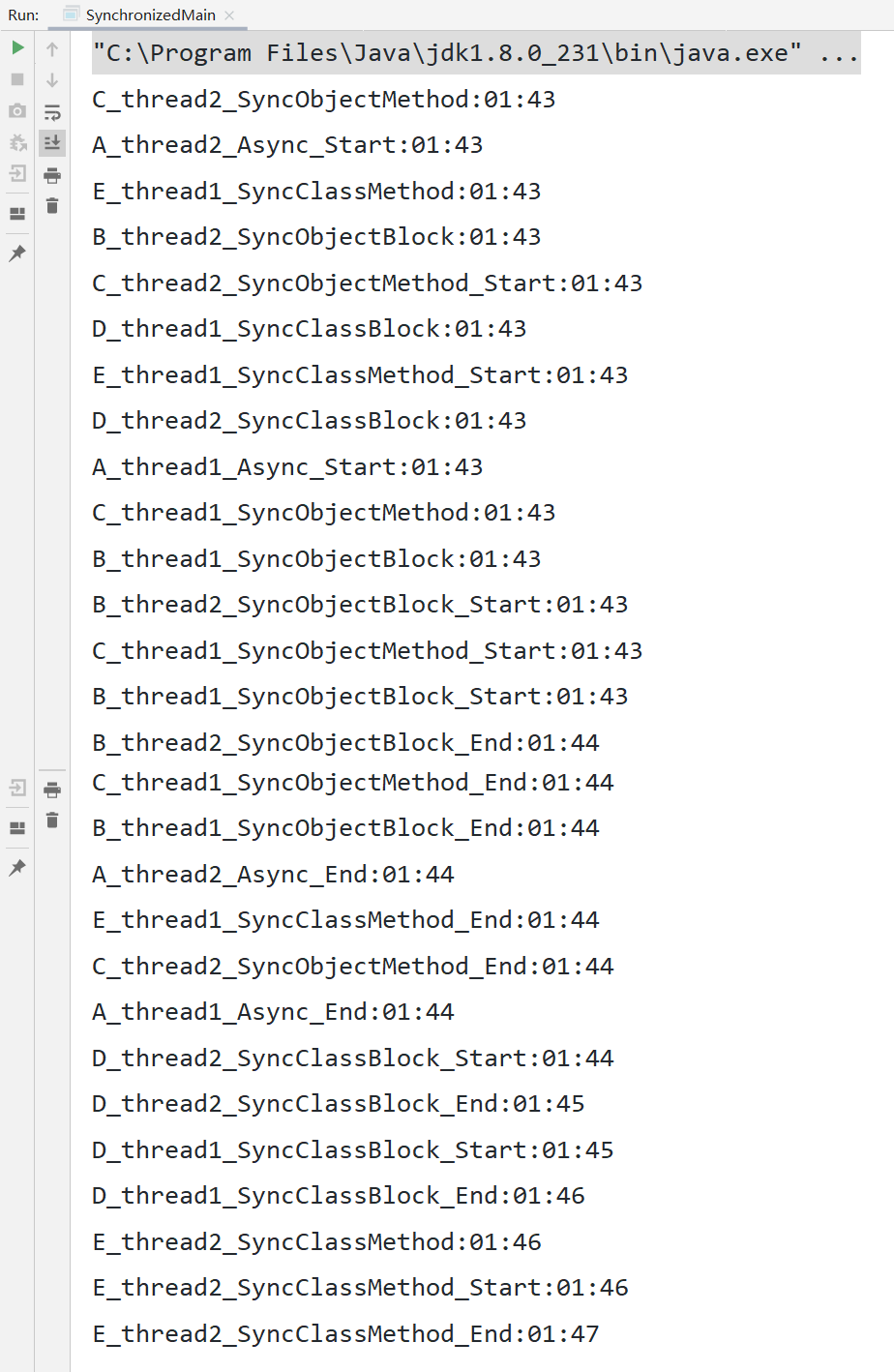最近发现synchronized锁的是什么?甚至有人认为synchronized锁的是代码??!这个我觉得还是很有必要通过实际的示例来说明synchronized锁的到底是什么。
根据获取的锁的分类:获取对象锁和获取类锁!
获取对象锁的两种用法
1、同步代码块(synchronized(this), synchronized(类实例对象)),锁是小括号()中的实例对象。
2、同步非静态方法(synchronized method),锁是当前对象的实例对象。
获取类锁的两种用法
1、同步代码块(synchronized(类.class)),锁是小括号()中的类对象,即Class对象。
2、同步静态方法(synchronized static method),锁是当前对象的类对象(Class对象)。
对象锁示例
看看这样一段代码:
SynchronizedDemo.java
package thread_study.synchronize;
import java.text.SimpleDateFormat;
import java.util.Date;
import java.util.concurrent.TimeUnit;
public class SynchronizedDemo implements Runnable{
public void run() {
String threadName = Thread.currentThread().getName();
if(threadName.startsWith("A")){
async();
}else if(threadName.startsWith("B")){
syncObjectBlock();
}else if(threadName.startsWith("C")){
syncObjectMethod();
}
}
private void async() {
try {
System.out.println(Thread.currentThread().getName()
+ "_Async_Start:"
+ new SimpleDateFormat("mm:ss").format(new Date()));
TimeUnit.SECONDS.sleep(1);
System.out.println(Thread.currentThread().getName()
+ "_Async_End:"
+ new SimpleDateFormat("mm:ss").format(new Date()));
} catch (InterruptedException e) {
e.printStackTrace();
}
}
private synchronized void syncObjectMethod() {
System.out.println(Thread.currentThread().getName()
+ "_SyncObjectMethod:"
+ new SimpleDateFormat("mm:ss").format(new Date()));
try {
System.out.println(Thread.currentThread().getName()
+ "_SyncObjectMethod_Start:"
+ new SimpleDateFormat("mm:ss").format(new Date()));
TimeUnit.SECONDS.sleep(1);
System.out.println(Thread.currentThread().getName()
+ "_SyncObjectMethod_End:"
+ new SimpleDateFormat("mm:ss").format(new Date()));
} catch (InterruptedException e) {
e.printStackTrace();
}
}
private void syncObjectBlock() {
System.out.println(Thread.currentThread().getName()
+ "_SyncObjectBlock:"
+ new SimpleDateFormat("mm:ss").format(new Date()));
synchronized (this){
try {
System.out.println(Thread.currentThread().getName()
+ "_SyncObjectBlock_Start:"
+ new SimpleDateFormat("mm:ss").format(new Date()));
TimeUnit.SECONDS.sleep(1);
System.out.println(Thread.currentThread().getName()
+ "_SyncObjectBlock_End:"
+ new SimpleDateFormat("mm:ss").format(new Date()));
} catch (InterruptedException e) {
e.printStackTrace();
}
}
}
}
SynchronizedMain.java
package thread_study.synchronize;
public class SynchronizedMain {
public static void main(String[] args) {
SynchronizedDemo demo = new SynchronizedDemo();
Thread A_thread1 = new Thread(demo, "A_thread1");
Thread A_thread2 = new Thread(demo, "A_thread2");
Thread B_thread1 = new Thread(demo, "B_thread1");
Thread B_thread2 = new Thread(demo, "B_thread2");
Thread C_thread1 = new Thread(demo, "C_thread1");
Thread C_thread2 = new Thread(demo, "C_thread2");
A_thread1.start();
A_thread2.start();
B_thread1.start();
B_thread2.start();
C_thread1.start();
C_thread2.start();
}
}

但是如果我们传入不同的对象呢?
package thread_study.synchronize;
public class SynchronizedMain {
public static void main(String[] args) {
//SynchronizedDemo demo = new SynchronizedDemo();
Thread A_thread1 = new Thread(new SynchronizedDemo(), "A_thread1");
Thread A_thread2 = new Thread(new SynchronizedDemo(), "A_thread2");
Thread B_thread1 = new Thread(new SynchronizedDemo(), "B_thread1");
Thread B_thread2 = new Thread(new SynchronizedDemo(), "B_thread2");
Thread C_thread1 = new Thread(new SynchronizedDemo(), "C_thread1");
Thread C_thread2 = new Thread(new SynchronizedDemo(), "C_thread2");
A_thread1.start();
A_thread2.start();
B_thread1.start();
B_thread2.start();
C_thread1.start();
C_thread2.start();
}
}

从上面的代码和结果中我们可以得出一个结论,那就是
获取对象锁的两种用法:
1、同步代码块(synchronized(this), synchronized(类实例对象)),锁是小括号()中的实例对象。
2、同步非静态方法(synchronized method),锁是当前对象的实例对象。
同步非静态方法锁住整个方法,而同步代码块只是锁住的只是方法中的一部分代码
获取类锁的两种用法
1、同步代码块(synchronized(类.class)),锁是小括号()中的类对象,即Class对象。
2、同步静态方法(synchronized static method),锁是当前对象的类对象(Class对象)。
同步静态方法锁住整个方法,而同步代码块只是锁住的只是方法中的一部分代码,与上面一样的
类锁示例
下面来看看同步静态方法和同步代码块(synchronized(类.class))的效果吧:
package thread_study.synchronize;
import java.text.SimpleDateFormat;
import java.util.Date;
import java.util.concurrent.TimeUnit;
public class SynchronizedDemo implements Runnable{
public void run() {
String threadName = Thread.currentThread().getName();
if(threadName.startsWith("A")){
async();
}else if(threadName.startsWith("B")){
syncObjectBlock();
}else if(threadName.startsWith("C")){
syncObjectMethod();
}else if(threadName.startsWith("D")){
syncClassBlock();
}else if(threadName.startsWith("E")){
syncClassMethod();
}
}
private synchronized static void syncClassMethod() {
System.out.println(Thread.currentThread().getName()
+ "_SyncClassMethod:"
+ new SimpleDateFormat("mm:ss").format(new Date()));
try {
System.out.println(Thread.currentThread().getName()
+ "_SyncClassMethod_Start:"
+ new SimpleDateFormat("mm:ss").format(new Date()));
TimeUnit.SECONDS.sleep(1);
System.out.println(Thread.currentThread().getName()
+ "_SyncClassMethod_End:"
+ new SimpleDateFormat("mm:ss").format(new Date()));
} catch (InterruptedException e) {
e.printStackTrace();
}
}
private void syncClassBlock() {
System.out.println(Thread.currentThread().getName()
+ "_SyncClassBlock:"
+ new SimpleDateFormat("mm:ss").format(new Date()));
synchronized (SynchronizedDemo.class){
try {
System.out.println(Thread.currentThread().getName()
+ "_SyncClassBlock_Start:"
+ new SimpleDateFormat("mm:ss").format(new Date()));
TimeUnit.SECONDS.sleep(1);
System.out.println(Thread.currentThread().getName()
+ "_SyncClassBlock_End:"
+ new SimpleDateFormat("mm:ss").format(new Date()));
} catch (InterruptedException e) {
e.printStackTrace();
}
}
}
private void async() {
try {
System.out.println(Thread.currentThread().getName()
+ "_Async_Start:"
+ new SimpleDateFormat("mm:ss").format(new Date()));
TimeUnit.SECONDS.sleep(1);
System.out.println(Thread.currentThread().getName()
+ "_Async_End:"
+ new SimpleDateFormat("mm:ss").format(new Date()));
} catch (InterruptedException e) {
e.printStackTrace();
}
}
//...和上面一样的
}
SynchronizedMain.java
package thread_study.synchronize;
public class SynchronizedMain {
public static void main(String[] args) {
Thread A_thread1 = new Thread(new SynchronizedDemo(), "A_thread1");
Thread A_thread2 = new Thread(new SynchronizedDemo(), "A_thread2");
Thread D_thread1 = new Thread(new SynchronizedDemo(), "D_thread1");
Thread D_thread2 = new Thread(new SynchronizedDemo(), "D_thread2");
Thread E_thread1 = new Thread(new SynchronizedDemo(), "E_thread1");
Thread E_thread2 = new Thread(new SynchronizedDemo(), "E_thread2");
A_thread1.start();
A_thread2.start();
D_thread1.start();
D_thread2.start();
E_thread1.start();
E_thread2.start();
}
}

对象锁和类锁不会干扰
最后看看类锁和对象锁是否会相互影响呢?
修改一下代码:
package thread_study.synchronize;
public class SynchronizedMain {
public static void main(String[] args) {
//SynchronizedDemo demo = new SynchronizedDemo();
Thread A_thread1 = new Thread(new SynchronizedDemo(), "A_thread1");
Thread A_thread2 = new Thread(new SynchronizedDemo(), "A_thread2");
Thread B_thread1 = new Thread(new SynchronizedDemo(), "B_thread1");
Thread B_thread2 = new Thread(new SynchronizedDemo(), "B_thread2");
Thread C_thread1 = new Thread(new SynchronizedDemo(), "C_thread1");
Thread C_thread2 = new Thread(new SynchronizedDemo(), "C_thread2");
Thread D_thread1 = new Thread(new SynchronizedDemo(), "D_thread1");
Thread D_thread2 = new Thread(new SynchronizedDemo(), "D_thread2");
Thread E_thread1 = new Thread(new SynchronizedDemo(), "E_thread1");
Thread E_thread2 = new Thread(new SynchronizedDemo(), "E_thread2");
A_thread1.start();
A_thread2.start();
B_thread1.start();
B_thread2.start();
C_thread1.start();
C_thread2.start();
D_thread1.start();
D_thread2.start();
E_thread1.start();
E_thread2.start();
}
}

可以看出来,类锁和对象锁是不会相互干扰的!
- 本文作者: Tim
- 本文链接: https://zouchanglin.cn/2020/03/28/3254260081.html
- 版权声明: 本博客所有文章除特别声明外,均采用 CC BY-SA 4.0 许可协议。转载请注明出处!























 1435
1435











 被折叠的 条评论
为什么被折叠?
被折叠的 条评论
为什么被折叠?








